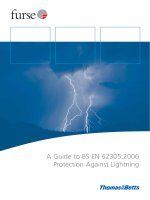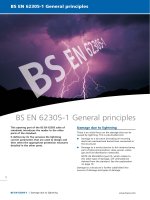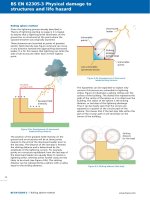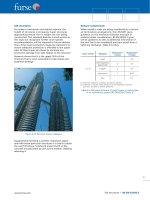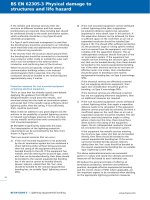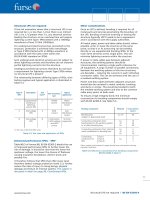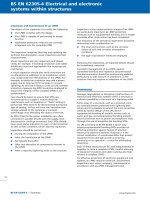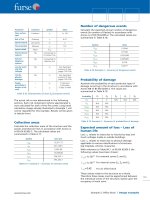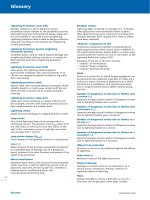Bsi bs en 00374 2 2014
Bạn đang xem bản rút gọn của tài liệu. Xem và tải ngay bản đầy đủ của tài liệu tại đây (972.01 KB, 14 trang )
BS EN 374-2:2014
BSI Standards Publication
Protective gloves against
dangerous chemicals and
micro-organisms
Part 2: Determination of resistance to
penetration
BS EN 374-2:2014
BRITISH STANDARD
National foreword
This British Standard is the UK implementation of EN 374-2:2014. It
supersedes BS EN 374-2:2003 which is withdrawn.
The UK participation in its preparation was entrusted to Technical
Committee PH/3/8, Protective gloves.
A list of organizations represented on this committee can be
obtained on request to its secretary.
This publication does not purport to include all the necessary
provisions of a contract. Users are responsible for its correct
application.
© The British Standards Institution 2015. Published by BSI Standards
Limited 2015
ISBN 978 0 580 82485 2
ICS 13.340.40
Compliance with a British Standard cannot confer immunity from
legal obligations.
This British Standard was published under the authority of the
Standards Policy and Strategy Committee on 31 January 2015.
Amendments issued since publication
Date
Text affected
BS EN 374-2:2014
EN 374-2
EUROPEAN STANDARD
NORME EUROPÉENNE
EUROPÄISCHE NORM
December 2014
ICS 13.340.40
Supersedes EN 374-2:2003
English Version
Protective gloves against dangerous chemicals and microorganisms - Part 2: Determination of resistance to penetration
Gants de protection contre les produits chimiques et les
micro-organismes dangereux - Partie 2 : Détermination de
la résistance à la pénétration
Schutzhandschuhe gegen gefährliche Chemikalien und
Mikroorganismen - Teil 2: Bestimmung des Widerstandes
gegen Penetration
This European Standard was approved by CEN on 22 November 2014.
CEN members are bound to comply with the CEN/CENELEC Internal Regulations which stipulate the conditions for giving this European
Standard the status of a national standard without any alteration. Up-to-date lists and bibliographical references concerning such national
standards may be obtained on application to the CEN-CENELEC Management Centre or to any CEN member.
This European Standard exists in three official versions (English, French, German). A version in any other language made by translation
under the responsibility of a CEN member into its own language and notified to the CEN-CENELEC Management Centre has the same
status as the official versions.
CEN members are the national standards bodies of Austria, Belgium, Bulgaria, Croatia, Cyprus, Czech Republic, Denmark, Estonia,
Finland, Former Yugoslav Republic of Macedonia, France, Germany, Greece, Hungary, Iceland, Ireland, Italy, Latvia, Lithuania,
Luxembourg, Malta, Netherlands, Norway, Poland, Portugal, Romania, Slovakia, Slovenia, Spain, Sweden, Switzerland, Turkey and United
Kingdom.
EUROPEAN COMMITTEE FOR STANDARDIZATION
COMITÉ EUROPÉEN DE NORMALISATION
EUROPÄISCHES KOMITEE FÜR NORMUNG
CEN-CENELEC Management Centre: Avenue Marnix 17, B-1000 Brussels
© 2014 CEN
All rights of exploitation in any form and by any means reserved
worldwide for CEN national Members.
Ref. No. EN 374-2:2014 E
BS EN 374-2:2014
EN 374-2:2014 (E)
Contents
Page
Foreword ..............................................................................................................................................................3
1
Scope ......................................................................................................................................................4
2
Normative references ............................................................................................................................4
3
Terms and definitions ...........................................................................................................................4
4
4.1
4.2
4.3
Principle of tests ....................................................................................................................................4
Air leak test.............................................................................................................................................4
Water leak test........................................................................................................................................4
Remarks ..................................................................................................................................................4
5
Sampling .................................................................................................................................................4
6
6.1
6.2
Apparatus ...............................................................................................................................................5
Air leak test.............................................................................................................................................5
Water leak test........................................................................................................................................6
7
7.1
7.2
7.3
Procedure ...............................................................................................................................................8
General ....................................................................................................................................................8
Air leak test.............................................................................................................................................8
Water leak test........................................................................................................................................9
8
Test report ..............................................................................................................................................9
Annex A (informative) Informative annex to be used for quality assurance during production ............ 10
2
BS EN 374-2:2014
EN 374-2:2014 (E)
Foreword
This document (EN 374-2:2014) has been prepared by Technical Committee CEN/TC 162 “Protective clothing
including hand and arm protection and lifejackets”, the secretariat of which is held by DIN.
This European Standard shall be given the status of a national standard, either by publication of an identical
text or by endorsement, at the latest by June 2015, and conflicting national standards shall be withdrawn at
the latest by June 2015.
This document supersedes EN 374-2:2003.
Attention is drawn to the possibility that some of the elements of this document may be the subject of patent
rights. CEN [and/or CENELEC] shall not be held responsible for identifying any or all such patent rights.
This document has been prepared under a mandate given to CEN by the European Commission and the
European Free Trade Association.
The major changes in comparison to EN 374-2:2003 are:
−
reference to EN 374-3 changed to EN 16523-1;
−
no classification concerning effective barrier to micro-biological hazards by resistance to penetration;
−
clearer wording in test principles and test report;
−
informative Annex A (AQL) not be tested, for the purpose of production control only, e. g. by the
manufacturer or auditing organization.
EN 374 consists of the following parts under the general title, Protective gloves against chemicals and microorganisms:
-
Part 1: Terminology and performance requirements
-
Part 2: Determination of resistance to penetration
-
Part 3: Determination of resistance to permeation by chemicals
-
Part 4: Determination of resistance to degradation by chemicals
-
Part 5: Terminology and performance requirements for micro-organisms risks
According to the CEN-CENELEC Internal Regulations, the national standards organizations of the following
countries are bound to implement this European Standard: Austria, Belgium, Bulgaria, Croatia, Cyprus, Czech
Republic, Denmark, Estonia, Finland, Former Yugoslav Republic of Macedonia, France, Germany, Greece,
Hungary, Iceland, Ireland, Italy, Latvia, Lithuania, Luxembourg, Malta, Netherlands, Norway, Poland, Portugal,
Romania, Slovakia, Slovenia, Spain, Sweden, Switzerland, Turkey and the United Kingdom.
3
BS EN 374-2:2014
EN 374-2:2014 (E)
1
Scope
This European Standard specifies a test method for the penetration resistance of gloves that protect against
dangerous chemicals and/or micro-organisms.
2
Normative references
The following documents, in whole or in part, are normatively referenced in this document and are
indispensable for its application. For dated references, only the edition cited applies. For undated references,
the latest edition of the referenced document (including any amendments) applies.
EN 374-1, Protective gloves against chemicals and micro-organisms - Part 1: Terminology and performance
requirements
ISO 2859 (all parts), Sampling procedures and tables for inspection by attributes
3
Terms and definitions
For the purposes of this document the terms and definitions given in EN 374-1 apply.
4
4.1
Principle of tests
Air leak test
A glove is immersed in water, and its interior is pressurised with air. A leak is detected by a stream of air
bubbles from the surface of the glove.
4.2
Water leak test
A glove is filled with water. A leak is detected by the appearance of water droplets on the outside of the glove.
4.3
Remarks
The air leak procedure is not suitable for all gloves. For example parts of some gloves may be overinflated
while other parts of the same gloves can only be partially inflated. If the air leak test proves unsuitable, then
only the water penetration test is carried out.
For both methods disregard leaks within the area of 40 mm from the edge of the liquid proof area.
5
Sampling
For the purpose of testing, the test sample will be one glove of each size, with an overall minimum of
4 samples per performed test.
For certain reasons some gloves cannot be tested, e.g. non-homogenous overinflating of the samples or
thickness of the liners disables the fitting on the mandrel.
If one sample fails the penetration test, the test shall be reported as having failed.
For the purpose of production control, e. g. by the manufacturer or auditing organisation, see Annex A.
4
BS EN 374-2:2014
EN 374-2:2014 (E)
6
Apparatus
6.1
Air leak test
6.1.1 A circular fixing mandrel, tapered with an appropriate diameter range to effect an airtight seal with the
glove to be tested. It should be capable of rotation through 180°.
6.1.2
Means of air inflation.
6.1.3
Water tank.
6.1.4
Pressure gauge reading 0 kPa to 10 kPa.
6.1.5
Means of regulating the desired pressure.
Figure 1 and Figure 2 show an example of a suitable apparatus.
Key
1
To pressure gauge
2
Non-return valve
3
To instrument panel
4
Circular fixing mandrel
Figure 1 — Enlarged detail of the circular fixing mandrel
5
BS EN 374-2:2014
EN 374-2:2014 (E)
Key
1 Pressure gauge
6 Pressure gauge
2 Flexible pipes
7 Pressure regulator
3 Non return valve
8 Instrument panel
4 Circular fixing mandrel
9 Compressed air supply
5 Water supply
10 Tank
Figure 2 — Typical arrangement of air pressure testing apparatus
6.2
Water leak test
6.2.1 A clear open ended plastic tube is fitted with a hook at the upper end. The tube measures 380 mm in
length and has a diameter wide enough to fit the gloves under test. It has a mark 40 mm from the lower end
(see Figure 3).
6
BS EN 374-2:2014
EN 374-2:2014 (E)
Dimensions in millimetres
Figure 3 — Filltube with a hook
6.2.2
Elastic strapping with a "touch and close" fastener or other fastening material.
6.2.3 Stand with horizontal rod for hanging the hook end of the tube (see Figure 4). The supported rod shall
be capable of taking the weight of the total number of gloves that will be suspended at any one time.
6.2.4
A device capable of delivering a minimum of 1 000 ml water.
6.2.5 An alternative means of holding the glove may be used. The apparatus shall be capable of securing
the glove on a mandrel, with a diameter appropriate to fit the glove, so that it can be filled with water to within
40 mm from the edge of the liquid proof area. It shall be capable of holding water in excess of that required to
fill the glove.
7
BS EN 374-2:2014
EN 374-2:2014 (E)
Figure 4 — Stand for suspending the filltube
7
7.1
Procedure
General
Carefully remove the glove from the wrapper, box or its packaging. Record the identity code, lot number, size
and brand of samples. Visually examine for tears, rips and holes. If these are present, the gloves shall be
reported as having failed.
7.2
Air leak test
7.2.1 The glove is fastened to the circular mandrel and is inflated after immersion at ambient temperature,
with air, to a gauge pressure of X kPa (see Table 1) plus an overpressure of 1 kPa per 100 mm of immersion
measured at the fingertips closest to the bottom of the water tank. For example, for 250 mm of immersion at
the fingertips, 2,5 kPa shall be added to the air pressure specified in Table 1.
The inflation pressure shall be reached with a ± 10 % limit deviation within 2 min and the control of possible air
bubbles shall take an additional (30 ± 5) s.
Table 1 — Air pressure
8
Nominal glove thickness (e)
mm
As provided by the manufacturer
Air pressure (X)
kPa
e < 0,3
0,5
0,3 < e < 0,5
2,0
0,5 < e < 1,0
5,0
e > 1,0
6,0
BS EN 374-2:2014
EN 374-2:2014 (E)
7.2.2 For gloves up to 250 mm in length the immersion shall be carried out with the hand vertically
downwards so that the water covers the maximum possible surface of the glove.
For gloves over 250 mm in length the immersion is to be carried out, with the hand at a downward angle, to a
vertical depth of (250 ± 10) mm above the tip of the middle finger and so that the water covers the maximum
possible surface of the glove. Rotate the mandrel and examine the whole glove surface for the emergence of
air bubbles (see Figure 2).
7.3
Water leak test
7.3.1 The glove is attached to an open-ended plastic tube by bringing the edge of the cuff to the 40 mm
mark (see Figure 3) and fastening it with the elastic strap to make a watertight seal.
7.3.2 A minimum of 1 000 ml of water is added through the tube to fill the glove completely and to reach at
least the 40 mm mark level of the liquid proof area of the glove. The water shall be at ambient temperature.
Some of the 1 000 ml of water may remain in the fill tube depending on the glove being tested.
If it is required, the glove can be supported by some suitable means in order to avoid excessive distortion from
the weight of water.
7.3.3 The gloves are examined immediately for water leaks. The glove should not be squeezed. Only
minimal handling is required to detect leaks. Water droplets may be blotted to confirm leakage, or talcum
powder may be used to enhance droplet visibility.
7.3.4 If the glove does not leak immediately, the tube with the glove attached is suspended vertically (see
Figure 4) and re-examined 2 min (± 10s) after the initial addition of water. Again, using minimum handling, the
glove surface is checked for leaks.
8
Test report
The test report shall include:
—
A reference to this International Standard;
—
Full identity of the tested glove;
—
Visual inspection: pass or fail;
—
Air leak test and water leak test: pass or fail;
—
For the air leak test: air pressure used;
—
Reason of non-testing of any of the penetration tests;
—
Reporting of any deviation to the present standard.
9
BS EN 374-2:2014
EN 374-2:2014 (E)
Annex A
(informative)
Informative annex to be used for quality assurance during production
Gloves from a single lot or batch shall be sampled and inspected in accordance with ISO 2859 (all parts). The
inspection levels and acceptable quality levels (AQL) shall comply with those given in Table A.1 or as agreed
between the purchaser and the seller, if the latter is more stringent.
Table A.1 — Inspection levels and acceptable quality levels
Performance level
10
Acceptable quality level unit
Inspection levels
Level 3
< 0,65
G1
Level 2
< 1,5
G1
Level 1
< 4,0
S4
This page deliberately left blank
NO COPYING WITHOUT BSI PERMISSION EXCEPT AS PERMITTED BY COPYRIGHT LAW
British Standards Institution (BSI)
BSI is the national body responsible for preparing British Standards and other
standards-related publications, information and services.
BSI is incorporated by Royal Charter. British Standards and other standardization
products are published by BSI Standards Limited.
About us
Revisions
We bring together business, industry, government, consumers, innovators
and others to shape their combined experience and expertise into standards
-based solutions.
Our British Standards and other publications are updated by amendment or revision.
The knowledge embodied in our standards has been carefully assembled in
a dependable format and refined through our open consultation process.
Organizations of all sizes and across all sectors choose standards to help
them achieve their goals.
Information on standards
We can provide you with the knowledge that your organization needs
to succeed. Find out more about British Standards by visiting our website at
bsigroup.com/standards or contacting our Customer Services team or
Knowledge Centre.
Buying standards
You can buy and download PDF versions of BSI publications, including British
and adopted European and international standards, through our website at
bsigroup.com/shop, where hard copies can also be purchased.
If you need international and foreign standards from other Standards Development
Organizations, hard copies can be ordered from our Customer Services team.
Subscriptions
Our range of subscription services are designed to make using standards
easier for you. For further information on our subscription products go to
bsigroup.com/subscriptions.
With British Standards Online (BSOL) you’ll have instant access to over 55,000
British and adopted European and international standards from your desktop.
It’s available 24/7 and is refreshed daily so you’ll always be up to date.
You can keep in touch with standards developments and receive substantial
discounts on the purchase price of standards, both in single copy and subscription
format, by becoming a BSI Subscribing Member.
PLUS is an updating service exclusive to BSI Subscribing Members. You will
automatically receive the latest hard copy of your standards when they’re
revised or replaced.
To find out more about becoming a BSI Subscribing Member and the benefits
of membership, please visit bsigroup.com/shop.
With a Multi-User Network Licence (MUNL) you are able to host standards
publications on your intranet. Licences can cover as few or as many users as you
wish. With updates supplied as soon as they’re available, you can be sure your
documentation is current. For further information, email
BSI Group Headquarters
389 Chiswick High Road London W4 4AL UK
We continually improve the quality of our products and services to benefit your
business. If you find an inaccuracy or ambiguity within a British Standard or other
BSI publication please inform the Knowledge Centre.
Copyright
All the data, software and documentation set out in all British Standards and
other BSI publications are the property of and copyrighted by BSI, or some person
or entity that owns copyright in the information used (such as the international
standardization bodies) and has formally licensed such information to BSI for
commercial publication and use. Except as permitted under the Copyright, Designs
and Patents Act 1988 no extract may be reproduced, stored in a retrieval system
or transmitted in any form or by any means – electronic, photocopying, recording
or otherwise – without prior written permission from BSI. Details and advice can
be obtained from the Copyright & Licensing Department.
Useful Contacts:
Customer Services
Tel: +44 845 086 9001
Email (orders):
Email (enquiries):
Subscriptions
Tel: +44 845 086 9001
Email:
Knowledge Centre
Tel: +44 20 8996 7004
Email:
Copyright & Licensing
Tel: +44 20 8996 7070
Email:
